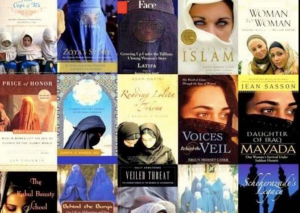I have a complicated take on veils (by which I mean actual veils, not the headscarves often poetically referred to as such).
I think them neither religiously mandated nor ultimately healthy for society. While some women certainly choose it freely and while I concede that veils play a more complex role in some places (especially environments where women lack the relative physical security that Westerners can take for granted), I think the veil’s primary function in most, for lack of a better word, “modern” settings today is to control women’s bodies and reimpose outmoded, unsustainable gender norms on society.
At the same time, I find the fixation on veils that one often encounters in Western media coverage of Muslim societies quite absurd. And deeply misogynistic, as well, for how it reduces Muslim women’s well being and self-expression to a trite binary. Even when Muslim women are dropping like flies from armed conflict, severe poverty, or a hellish combination of the two, far too many of their self-appointed defenders in the West remain preoccupied with their clothing and quite uninterested in tackling the problems they themselves find most pressing. With friends like these…
Veils are present to one extent or another in all Muslim societies and they are invested with great symbolic importance by people on both sides of the issue, so it’s natural that they often be used as a visual shorthand for certain aspects of Muslim life and culture.
But there is a dehumanizing side to the penchant of Western media to automatically trot out the veil imagery for Muslim women. One might dub it “Veil Porn.” What’s wrong with Veil Porn? For starters, a sizable segment (perhaps even the majority) of Muslim women worldwide do not wear hijab, much less the veil. So it isn’t terribly accurate in many cases. Second, for all the image’s ubiquity in the media how often have you seen a picture of veiled women living life? I’m no fan of veiling, but veils don’t turn women into lifeless mannequins, even in the most patriarchal of societies. Finally and most importantly, in a relatively secularized Western cultural backdrop, the incessant portrayal of Muslim women as veiled unconsciously sends the message to Westerners that Muslim women are interchangeable, one-dimensional beings defined exclusively by their religion.
What got me thinking about this was a fascinating blog post on the bigoted ways that translations of Arabic literature are often received, even by ostensibly sophisticated critics. The author writes, quoting American University in Cairo professor Adam Talib in “Translating for Bigots”:
“Translating Arab women characters is…extremely fraught. Why? Because if you’re a reader of modern Arabic literature, you know that what happens in modern Arabic literature. People date in modern Arabic literature; people have sex in modern Arabic literature; people drink and take drugs. And a lot of times, you will just translate what you find on the page, and you’ll find that reviewers find this peculiar.”
If a reviewer — who Talib sees as a proxy for the reader — finds an Arab woman not wrapped in ten layers of fabric, forced to marry her cross-eyed cousin, and pushed to the back seat of a car, then, “the reviewer says, ‘What an unrealistic depiction of Arab women.’”
“There is a hostility in the reader’s mind” to characters who don’t fit particular stereotypes, Talib said.
And it all starts with these damn book covers, which is the closest many people ever get to a real, flesh & blood Muslim.
I’m reminded of the vile attacks by Christian extremists on TLC’s “All American Muslim” reality show for, gasp, showing Muslim Americans who weren’t weird or extreme. They viewed the show’s absence of nasty, stereotypical Muslims as a cunning scheme to blind Americans to the real threat posed by Islam. Jon Stewart sent up the group’s hateful message with his typical brilliance:
The Daily Show
Get More: Daily Show Full Episodes,The Daily Show on Facebook











